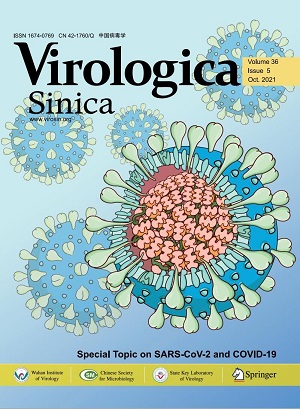In less than two years, SARS-CoV-2 has infected over two hundred million people and caused about 4.8 million deaths worldwide. With global efforts, over 6.3 billion vaccine doses have been administered, which largely reduce the mortality and control the virus spread. Meanwhile, the academia has never stopped the exploration to advance our knowledge in combatting the virus. In this issue, Virologica Sinica presents a collection of original articles that report the latest research progress on SARS-CoV-2, including studies on long COVID-19, development of systems for drugs and vaccines, new strategies on surveillance and counter-measures. The cover shows the basic structure of SARS-CoV-2 virus particles.
-
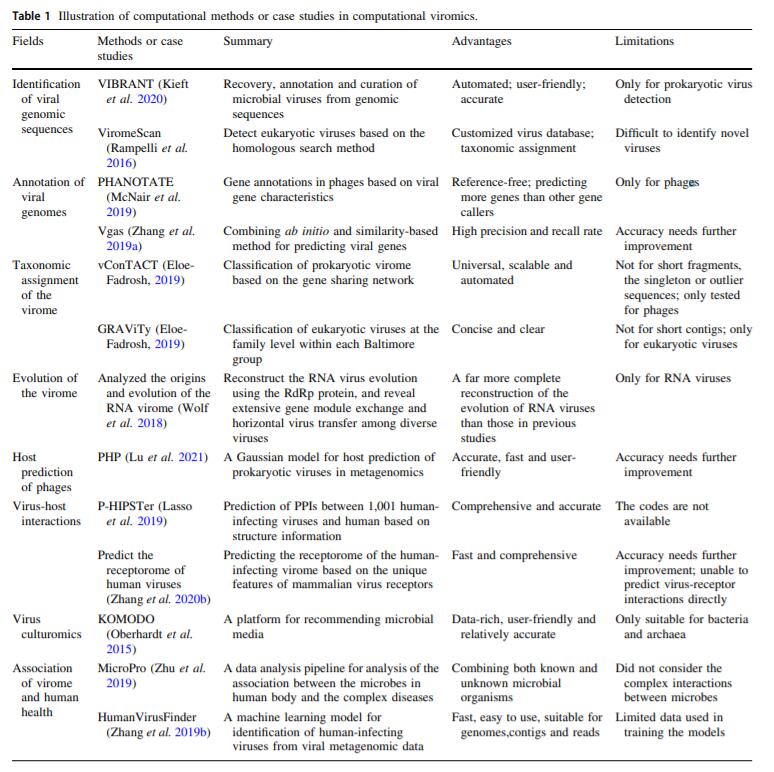
Computational Viromics: Applications of the Computational Biology in Viromics Studies
2021, 36(5): 1256 doi: 10.1007/s12250-021-00395-7
Received: 02 June 2020 Accepted: 14 April 2021 Published: 31 May 2021 -
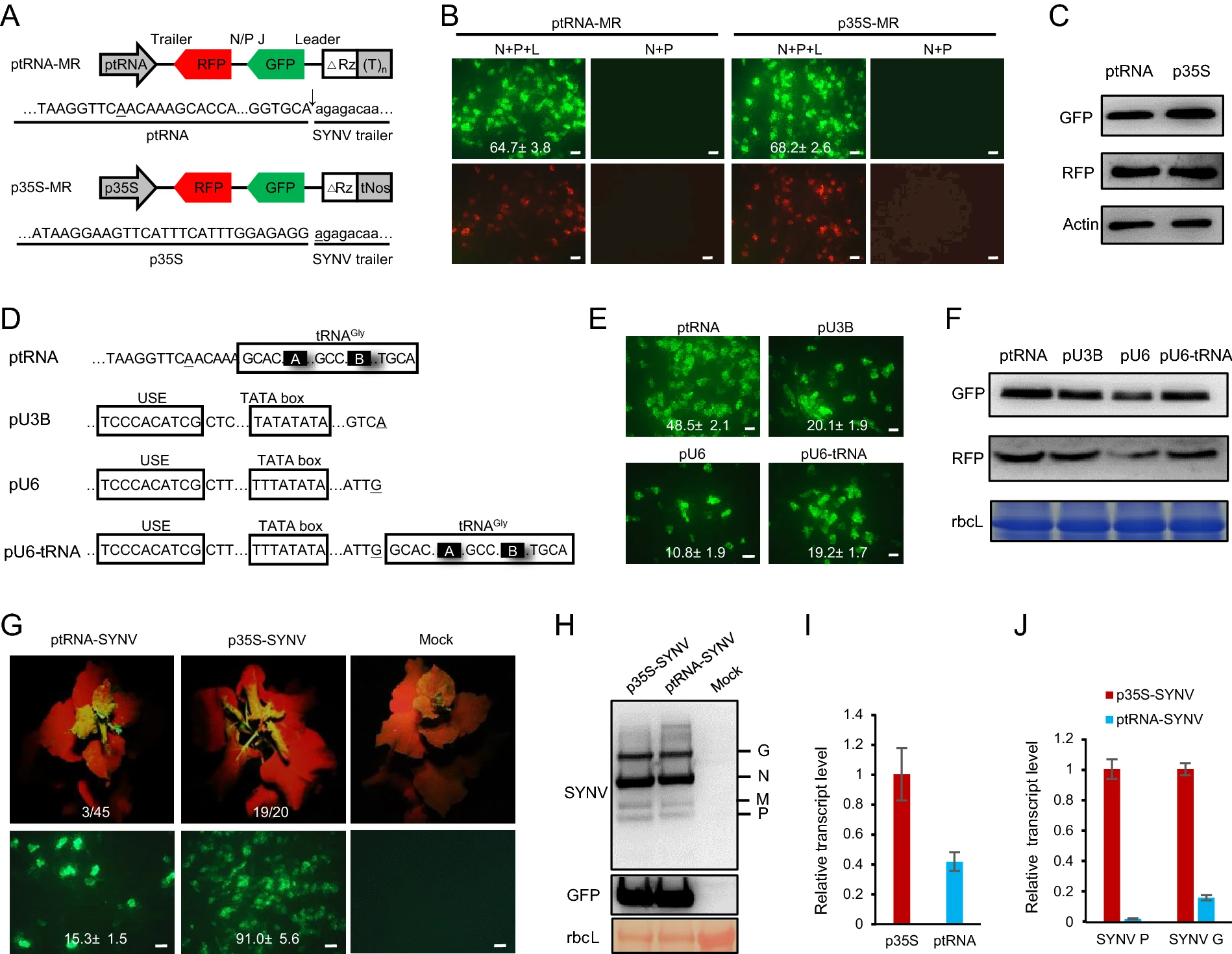
Development of RNA Polymerase III-Driven Reverse Genetics System for the Rescue of a Plant Rhabdovirus
2021, 36(5): 1252 doi: 10.1007/s12250-021-00390-y
Received: 23 November 2020 Accepted: 25 March 2021 Published: 03 May 2021 -

Beagle Dogs Have Low Susceptibility to Florida Clade 2 H3N8 Equine Avian Influenza
2021, 36(5): 1248 doi: 10.1007/s12250-021-00366-y
Received: 03 August 2020 Accepted: 25 January 2021 Published: 15 April 2021 -

Recombinant GII.4[P31] Was Predominant Norovirus Circulating in Beijing Area, China, 2018–2020
2021, 36(5): 1245 doi: 10.1007/s12250-021-00381-z
Received: 28 November 2020 Accepted: 20 February 2021 Published: 09 April 2021 -
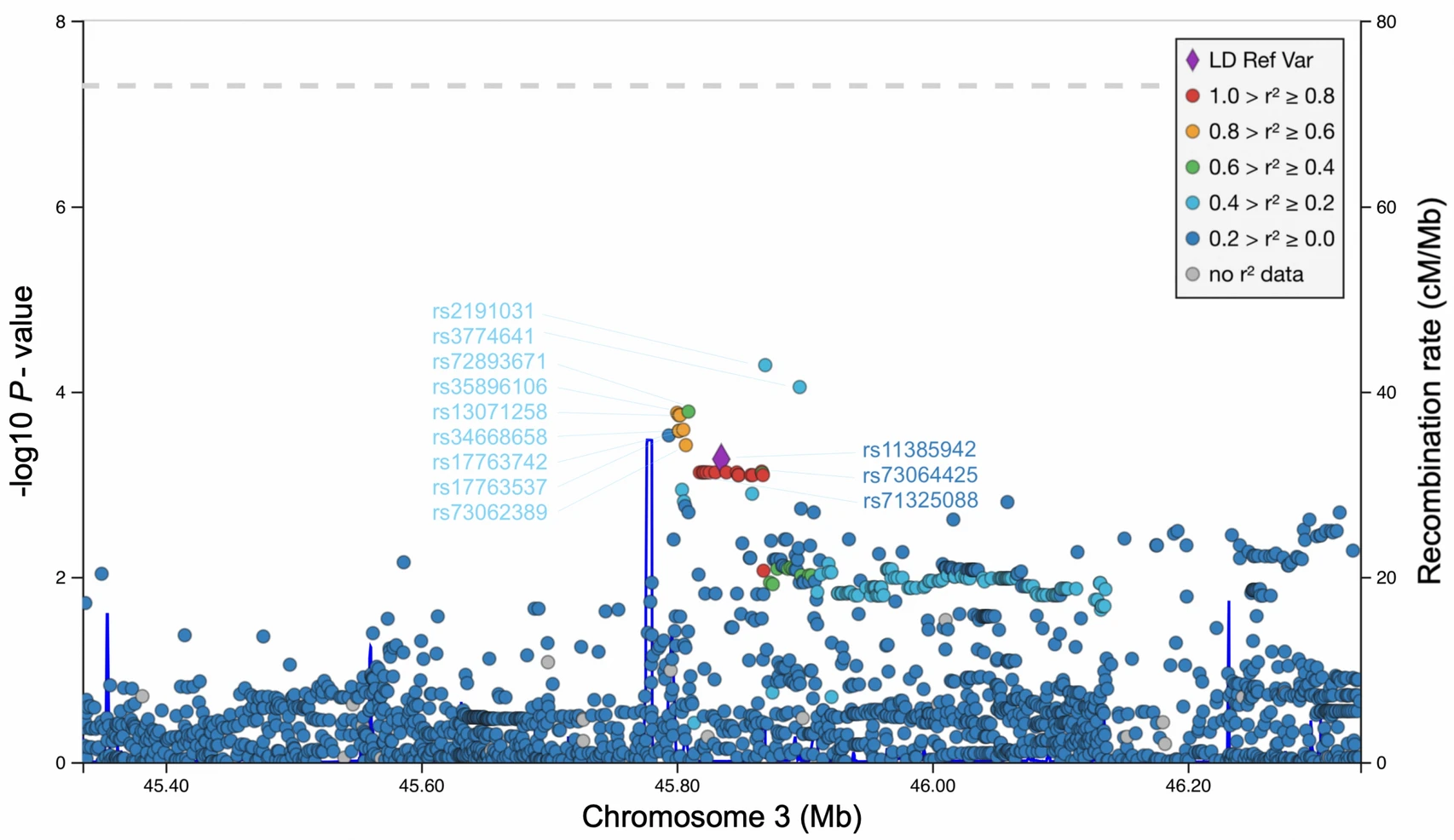
Replication of LZTFL1 Gene Region as a Susceptibility Locus for COVID-19 in Latvian Population
2021, 36(5): 1241 doi: 10.1007/s12250-021-00448-x
Received: 30 March 2021 Accepted: 24 August 2021 Published: 20 October 2021 -
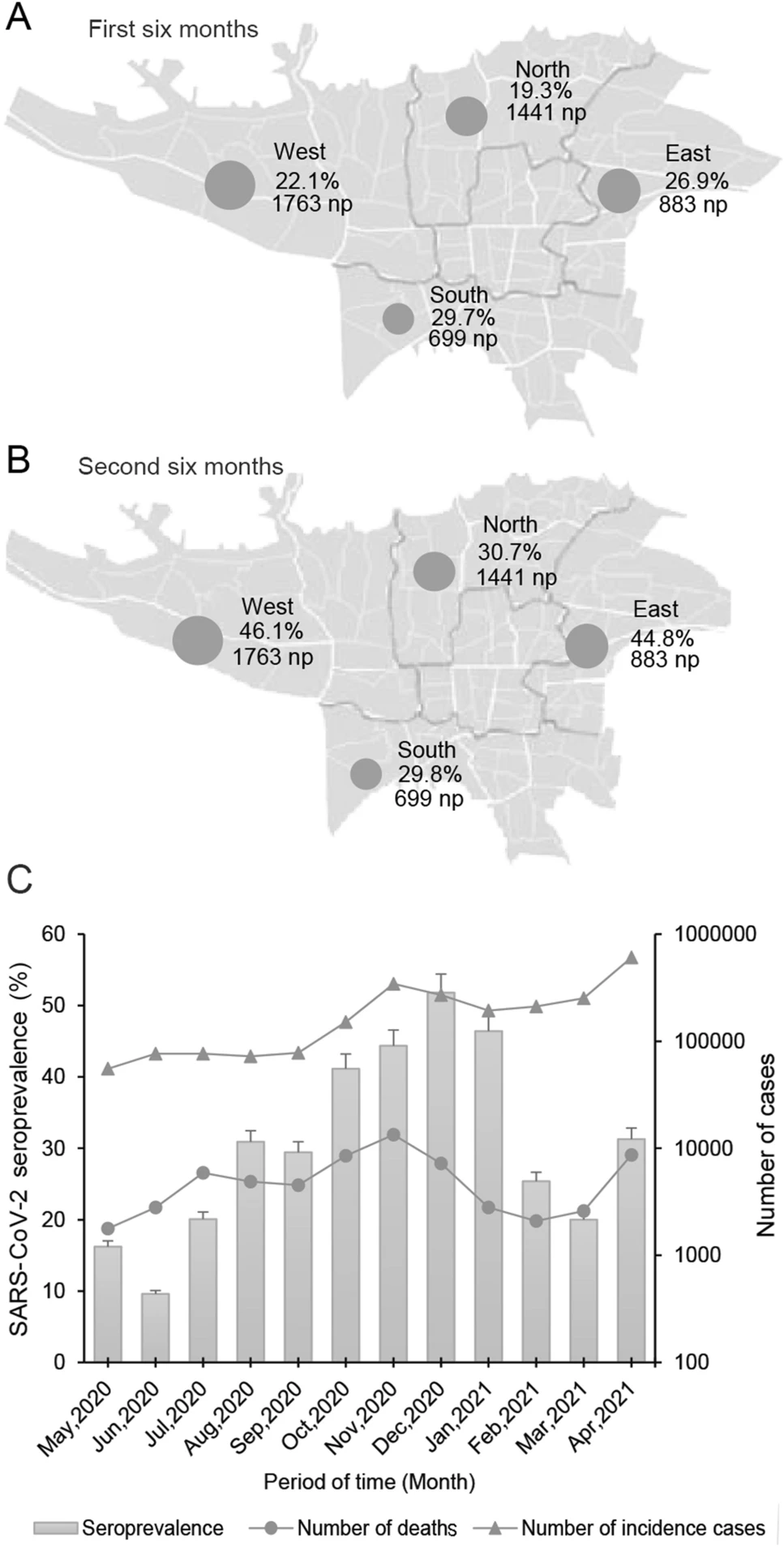
SARS-CoV-2 Seroprevalence in People Referred to Private Medical Laboratories in Different Districts of Tehran, Iran from May 2020 to April 2021
2021, 36(5): 1236 doi: 10.1007/s12250-021-00446-z
Received: 23 December 2020 Accepted: 28 June 2021 Published: 30 September 2021 -
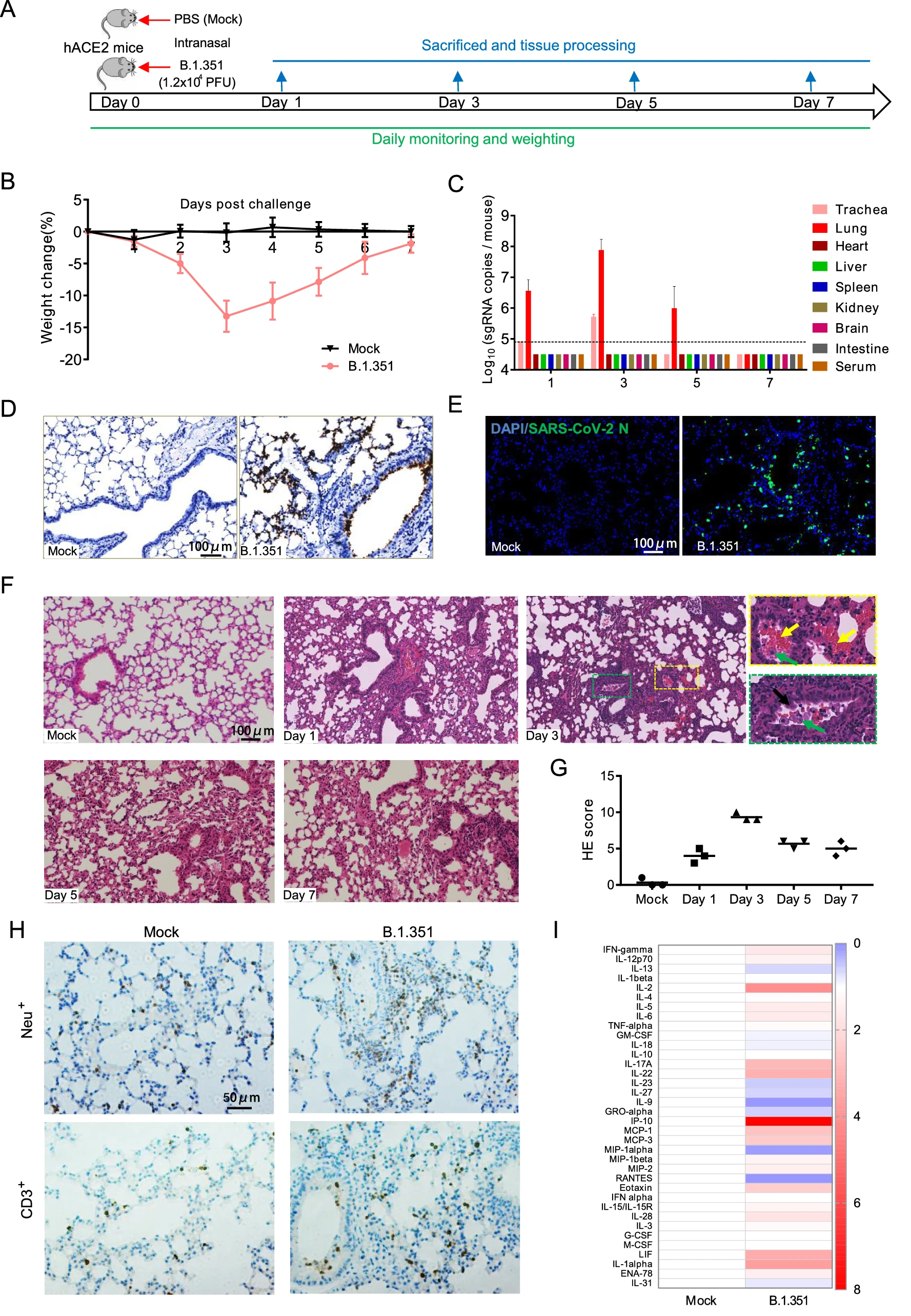
The Infection and Pathogenicity of SARS-CoV-2 Variant B.1.351 in hACE2 Mice
2021, 36(5): 1232 doi: 10.1007/s12250-021-00452-1
Received: 07 July 2021 Accepted: 24 August 2021 Published: 27 September 2021 -
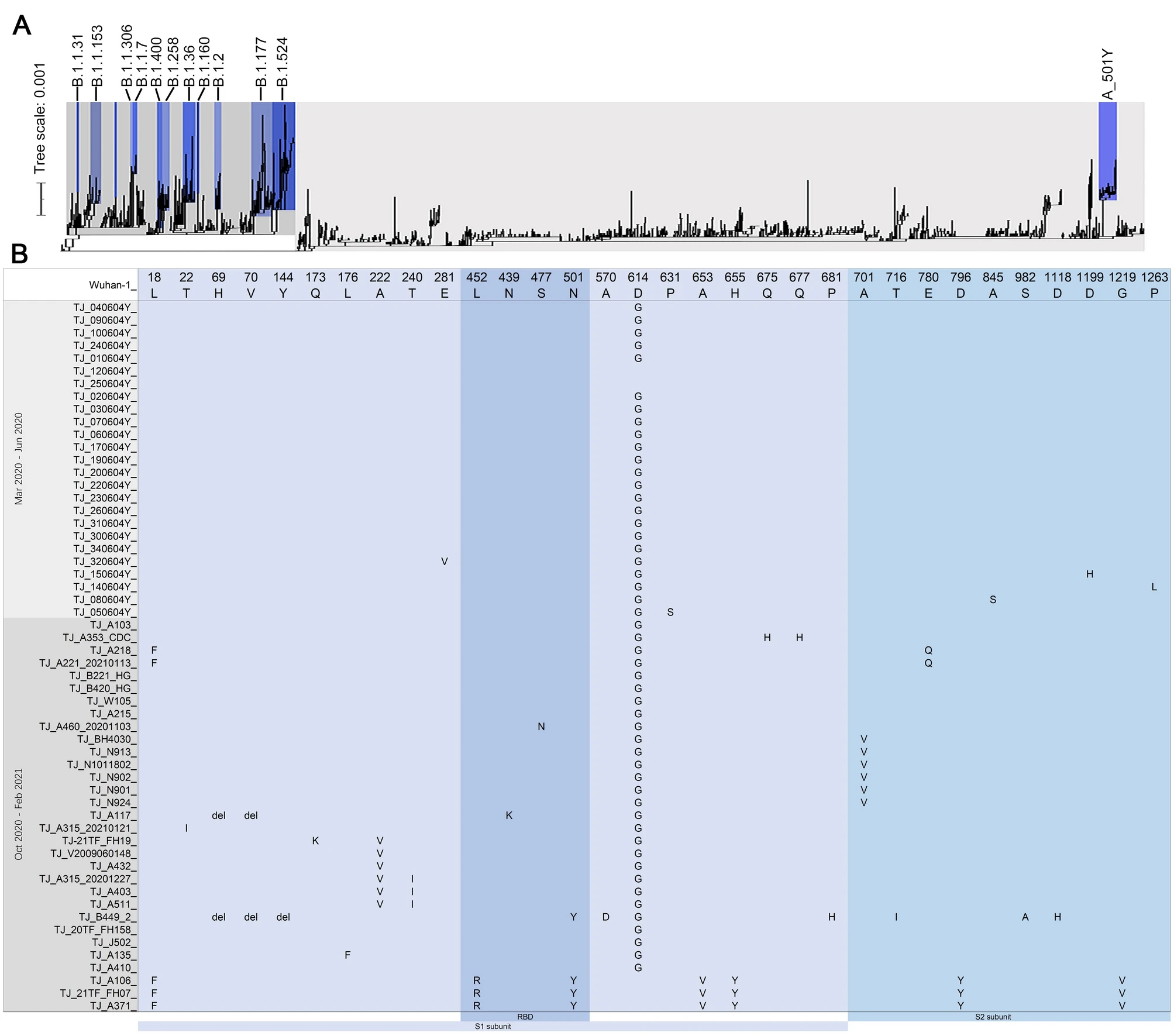
SARS-CoV-2 Genomic Sequencing Revealed N501Y and L452R Mutants of S/A Lineage in Tianjin Municipality, China
2021, 36(5): 1228 doi: 10.1007/s12250-021-00432-5
Received: 31 March 2021 Accepted: 26 May 2021 Published: 11 August 2021 -

Antigenic Drift of the Hemagglutinin from an Influenza A (H1N1) pdm09 Clinical Isolate Increases its Pathogenicity In Vitro
2021, 36(5): 1220 doi: 10.1007/s12250-021-00401-y
Received: 06 January 2021 Accepted: 12 April 2021 Published: 09 June 2021The influenza A (H1N1) pdm09 virus emerged in 2009 and has been continuously circulating in humans for over ten years. Here, we analyzed a clinical influenza A (H1N1) pdm09-infected patient case hospitalized for two months in Guangdong (from December 14, 2019 to February 15, 2020). This isolate, named A/Guangdong/LCF/2019 (LCF/19), was genetically sequenced, rescued by reverse genetics, and phylogenetically analyzed in the context of other relevant pdm09 isolates. Compared with earlier isolates, this pdm09 virus's genetic sequence contains four substitutions, S186P, T188I, D190A, and Q192E, of the hemagglutinin (HA) segment at position 186–192 (H3 numbering) in the epitope Sb, and two of which are located at the 190-helix. Phylogenetic analysis indicated that the epitope Sb started undergoing a rapid antigenic change in 2018. To characterize the pathogenicity of this novel substitution motif, a panel of reassortant viruses containing the LCF/2019 HA segment or the chimeric HA segment with the four substitutions were rescued. Kinetic growth data revealed that the reassortant viruses, including the LCF/2019 with the PTIAAQE substitution, propagated faster than those rescued ones having the STTADQQ motif in the epitope Sb in Madin-Darby Canine Kidney (MDCK) cells. The HI test showed that the binding activity of escape mutant to 2018 pdm09 sera was weaker than GLW/2018, suggesting that old vaccines might not effectively protect people from infection. Due to the difference in the selection of vaccine strains, people vaccinated in the southern hemisphere could still suffer a severe infection if infected with this antigenic drift pdm09 virus.
-
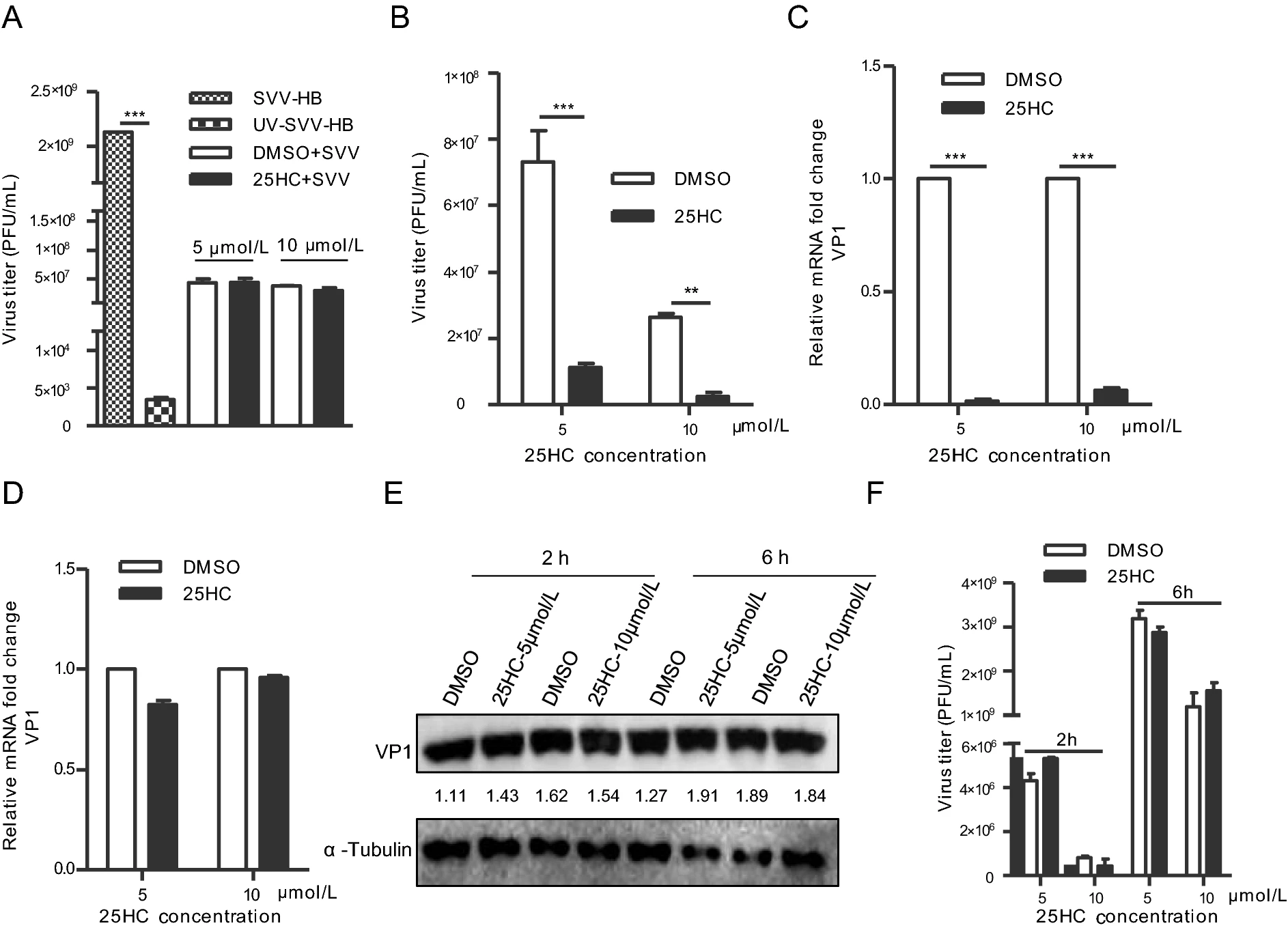
Cholesterol-25-Hydroxylase Suppresses Seneca Valley Virus Infection via Producing 25-Hydroxycholesterol to Block Adsorption Procedure
2021, 36(5): 1210 doi: 10.1007/s12250-021-00377-9
Received: 03 June 2020 Accepted: 22 September 2020 Published: 01 June 2021Cholesterol-25-hydroxylase (CH25H) is a membrane protein associated with endoplasmic reticulum, and it is an interferon-stimulated factor regulated by interferon. CH25H catalyzes cholesterol to produce 25-hydroxycholesterol (25HC) by adding a second hydroxyl to the 25th carbon atom of cholesterol. Recent studies have shown that both CH25H and 25HC could inhibit the replication of many viruses. In this study, we found that ectopic expression of CH25H in HEK-293T and BHK-21 cell lines could inhibit the replication of Seneca Valley virus (SVV) and that there was no species difference. On the other hand, the knockdown of CH25H could enhance the replication of SVV in HEK-293T and BHK-21 cells, indicating the importance of CH25H. To some extent, the CH25H mutant without hydroxylase activity also lost its ability to inhibit SVV amplification. Further studies demonstrated that 25HC was involved in the entire life cycle of SVV, especially in repressing its adsorption process. This study reveals that CH25H exerts the advantage of innate immunity mainly by producing 25HC to block virion adsorption.
-
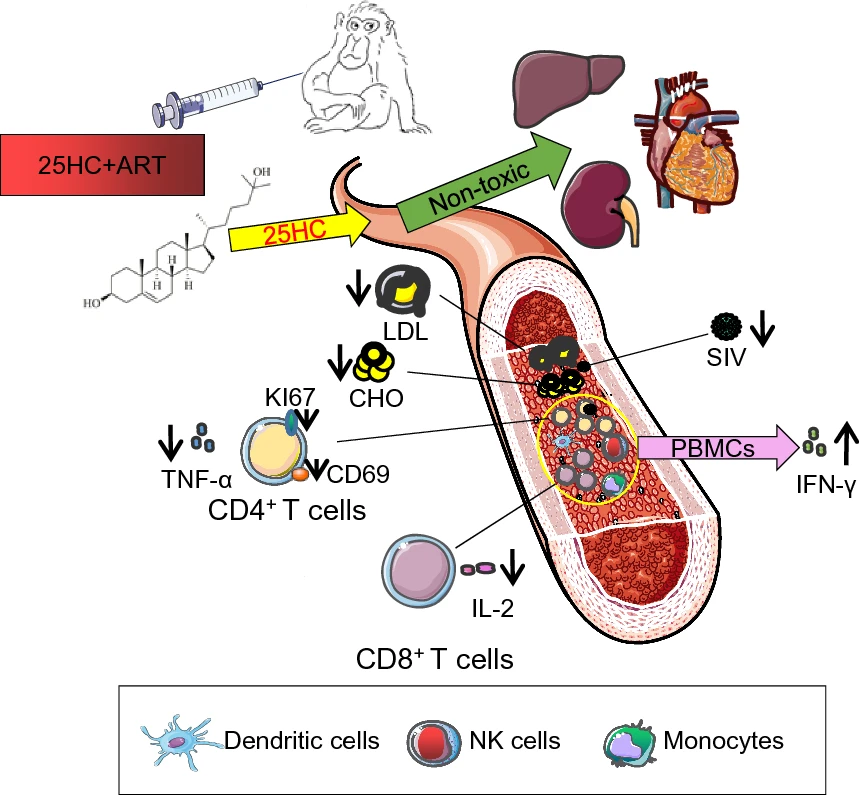
Modulation of Antiviral Immunity and Therapeutic Efficacy by 25-Hydroxycholesterol in Chronically SIV-Infected, ART-Treated Rhesus Macaques
2021, 36(5): 1197 doi: 10.1007/s12250-021-00407-6
Received: 29 January 2021 Accepted: 19 April 2021 Published: 31 May 2021Cholesterol-25-hydroxylase (CH25H) and its enzymatic product 25-hydroxycholesterol (25HC) exert broadly antiviral activity including inhibiting HIV-1 infection. However, their antiviral immunity and therapeutic efficacy in a nonhuman primate model are unknown. Here, we report that the regimen of 25HC combined with antiretroviral therapy (ART), provides profound immunological modulation towards inhibiting viral replication in chronically SIVmac239-infected rhesus macaques (RMs). Compared to the ART alone, this regimen more effectively controlled SIV replication, enhanced SIV-specific cellular immune responses, restored the ratio of CD4/CD8 cells, reversed the hyperactivation state of CD4+ T cells, and inhibited the secretion of proinflammatory cytokines by CD4+ and CD8+ T lymphocytes in chronically SIV-infected RMs. Furthermore, the in vivo safety and the preliminary pharmacokinetics of the 25HC compound were assessed in this RM model. Taken together, these assessments help explain the profound relationship between cholesterol metabolism, immune modulation, and antiviral activities by 25HC. These results provide insight for developing novel therapeutic drug candidates against HIV-1 infection and other related diseases.
-
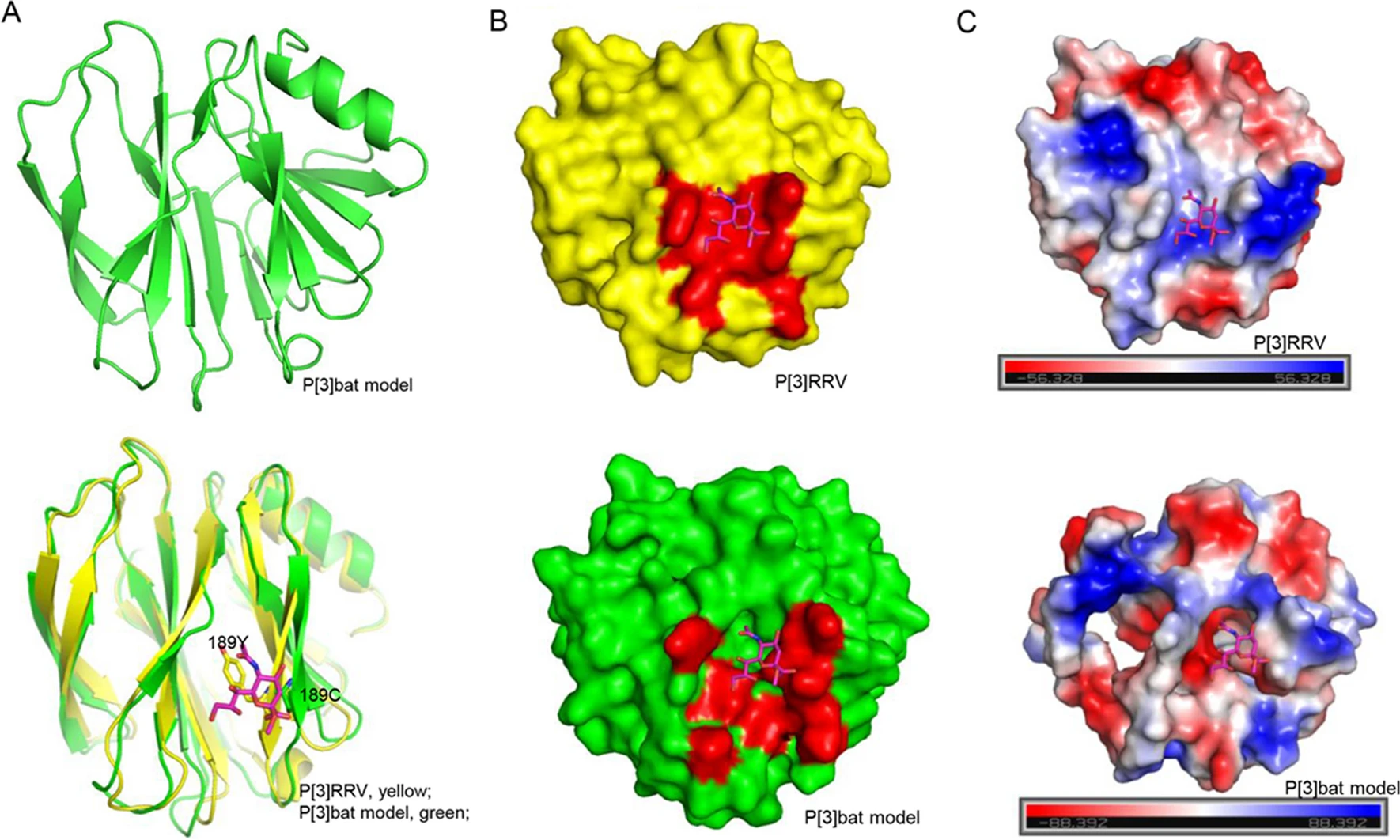
The Functional Characterization of Bat and Human P[3] Rotavirus VP8*s
2021, 36(5): 1187 doi: 10.1007/s12250-021-00400-z
Received: 06 January 2021 Accepted: 12 April 2021 Published: 31 May 2021P[3] rotavirus (RV) has been identified in many species, including human, simian, dog, and bat. Several glycans, including sialic acid, histo-blood group antigens (HBGAs) are reported as RV attachment factors. The glycan binding specificity of different P[3] RV VP8*s were investigated in this study. Human HCR3A and dog P[3] RV VP8*s recognized glycans with terminal sialic acid and hemagglutinated the red blood cells, while bat P[3] VP8* showed neither binding to glycans nor hemagglutination. However, the bat P[3] VP8* mutant of C189Y obtained the ability to hemagglutinate the red blood cells, while human P[3] HCR3A/M2-102 mutants of Y189C lost the ability. Sequence alignment and structural analysis indicated that residue 189 played an important role in the ligand recognition and may contribute to the cross-species transmission. Structural superimposition exhibited that bat P[3] VP8* model was quite different from the simian P[3] Rhesus rotavirus (RRV) P[3] VP8*, indicating that bat P[3] RV was relatively distinct and partially contributed to the no binding to tested glycans. These results promote our understanding of P[3] VP8*/glycans interactions and the potential transmission of bat/human P[3] RVs, offering more insight into the RV infection and prevalence.
-

Re-isolation of Wuxiang Virus from Wild Sandflies Collected from Yangquan County, China
2021, 36(5): 1177 doi: 10.1007/s12250-021-00398-4
Received: 17 November 2020 Accepted: 25 March 2021 Published: 31 May 2021We previously isolated a new species of the genus Phlebovirus from wild sandflies collected from Wuxiang County in central China, which named the Wuxiang virus (WUXV). In this study, we re-isolated the WUXV from wild sandflies collected from two villages in Yangquan County, China in 2019. Four virus isolates that caused cytopathic effects in BHK-21 cells were successfully isolated from sandfly specimens collected from chicken pens and sheep pens. Phylogenetic analyses of the L, M and S gene segments of the viruses revealed that the four virus strains represented the previously isolated WUXV. The minimum infection rate (MIR) of the virus isolated from the sheep pen was 3.21, and the MIR of the virus isolated from the chicken pen was 3.45. The positive rates of Wuxiang virus neutralizing antibodies in serum samples of local healthy people and domestic chickens were 8.7% (4/46) and 100% (4/4), respectively, suggesting that Wuxiang virus can infect human and animal. In view of the fact that Wuxiang virus is infectious to humans and animals and has a relatively wide geographical distribution in China, it is of great public health significance to strengthen the investigation and study on the infection status of Wuxiang virus in humans and animals.
-
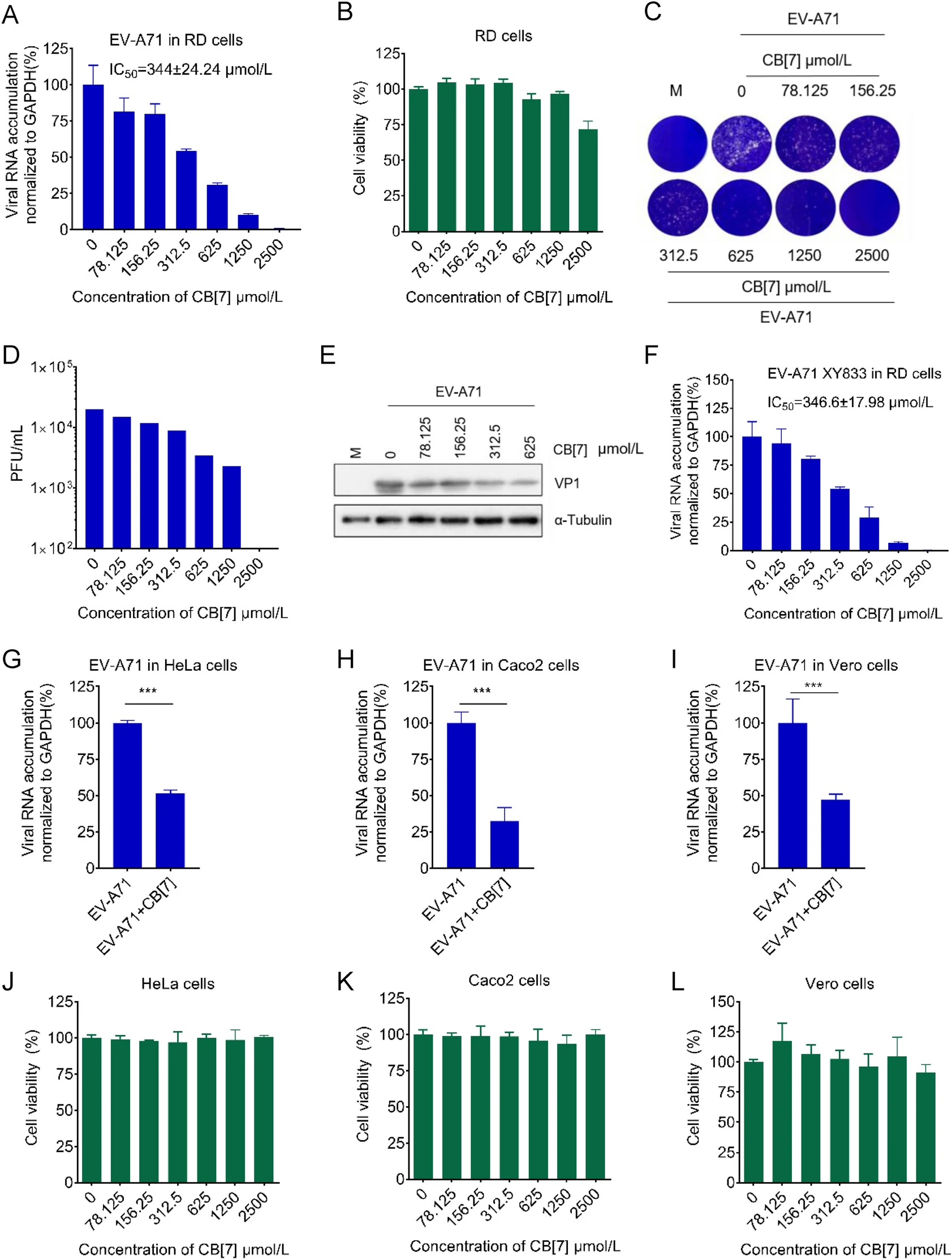
Cucurbit[7]uril as a Broad-Spectrum Antiviral Agent against Diverse RNA Viruses
2021, 36(5): 1165 doi: 10.1007/s12250-021-00404-9
Received: 25 March 2021 Accepted: 06 April 2021 Published: 26 May 2021The emergence and re-emergence of RNA virus outbreaks highlight the urgent need for the development of broad-spectrum antivirals. Polyamines are positively-charged small molecules required for the infectivity of a wide range of RNA viruses, therefore may become good antiviral targets. Cucurbit[7]uril (CB[7]), a synthetic macrocyclic molecule, which can bind with amine-based organic compounds with high affinity, has been shown to regulate bioactive molecules through competitive binding. In this study, we tested the antiviral activity of CB[7] against diverse RNA viruses, including a panel of enteroviruses (i.e. human enterovirus A71, coxsackievirus A16, coxsackievirus B3, and echovirus 11), some flaviviruses (i.e. dengue virus and Zika virus), and an alphavirus representative Semliki forest virus. CB[7] can inhibit virus replications in a variety of cell lines, and its mechanism of action is through the competitive binding with polyamines. Our findings not only for the first time provide evidence that CB[7] can be a promising broad-spectrum antiviral agent, but more importantly, offer a novel therapeutic strategy to fight against RNA viruses by supramolecular sequestration of polyamines.
-
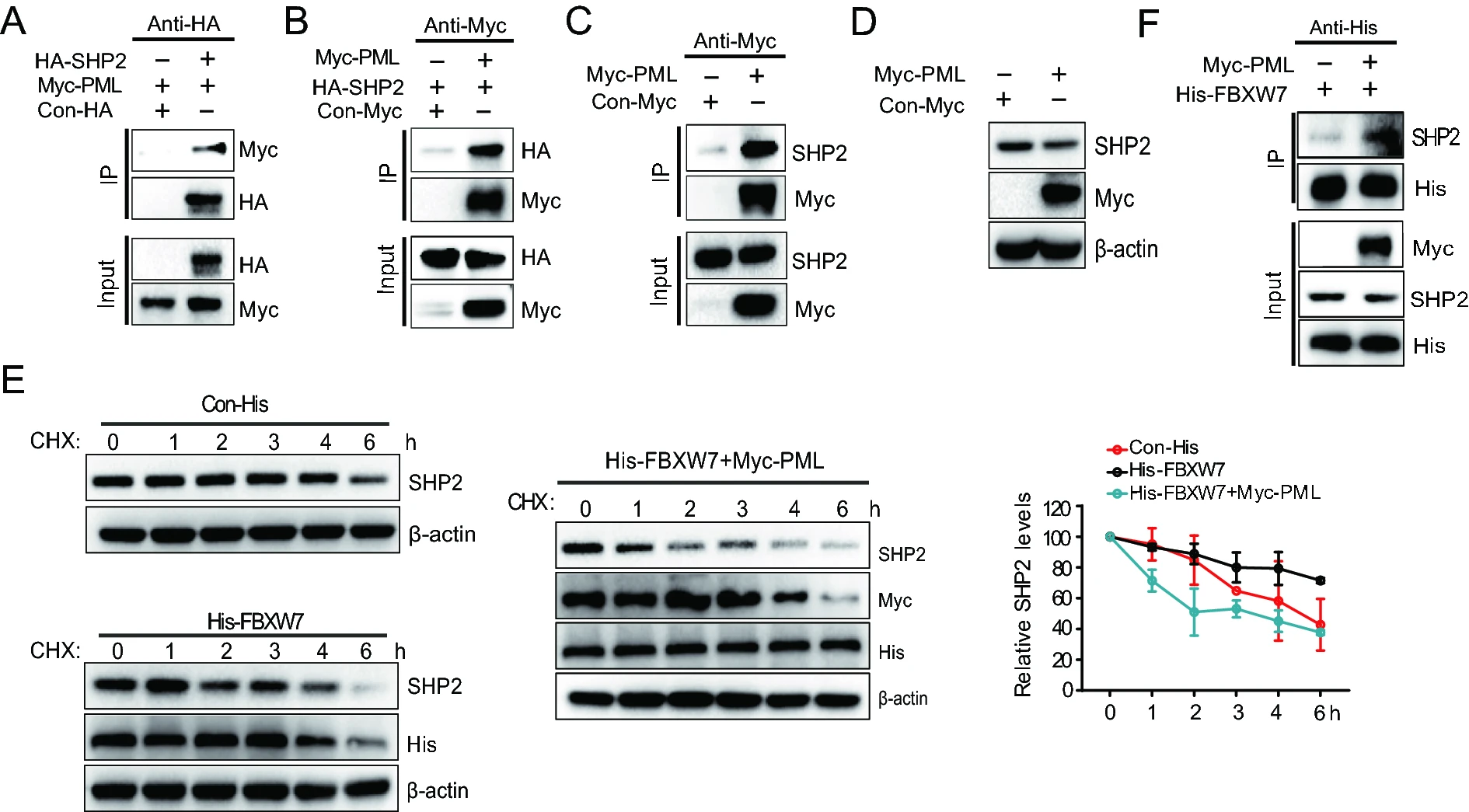
PML Suppresses Influenza Virus Replication by Promoting FBXW7 Expression
2021, 36(5): 1154 doi: 10.1007/s12250-021-00399-3
Received: 16 December 2020 Accepted: 29 March 2021 Published: 27 May 2021Influenza A viruses (IAV) are responsible for seasonal flu epidemics, which can lead to high morbidity and mortality each year. Like other viruses, influenza virus can hijack host cellular machinery for its replication. Host cells have evolved diverse cellular defense to resist the invasion of viruses. As the main components of promyelocytic leukemia protein nuclear bodies (PML-NBs), PML can inhibit the replication of many medically important viruses including IAV. However, the mechanism of PML against IAV is unclear. In the present study, we found PML was induced in response to IAV infection and ectopic expression of PML could inhibit IAV replication, whereas knockdown of endogenous PML expression could enhance IAV replication. Further studies showed that PML increased the expression of FBXW7 by inhibiting its K48-linked ubiquitination and enhanced the interaction between FBXW7 and SHP2, which negatively regulated IAV replication during infection. Moreover, PML stabilized RIG-I to promote the production of type Ⅰ IFN. Collectively, these data indicated that PML inhibited IAV replication by enhancing FBXW7 expression in the antiviral immunity against influenza virus and extended the mechanism of PML in antiviral immunity.
-
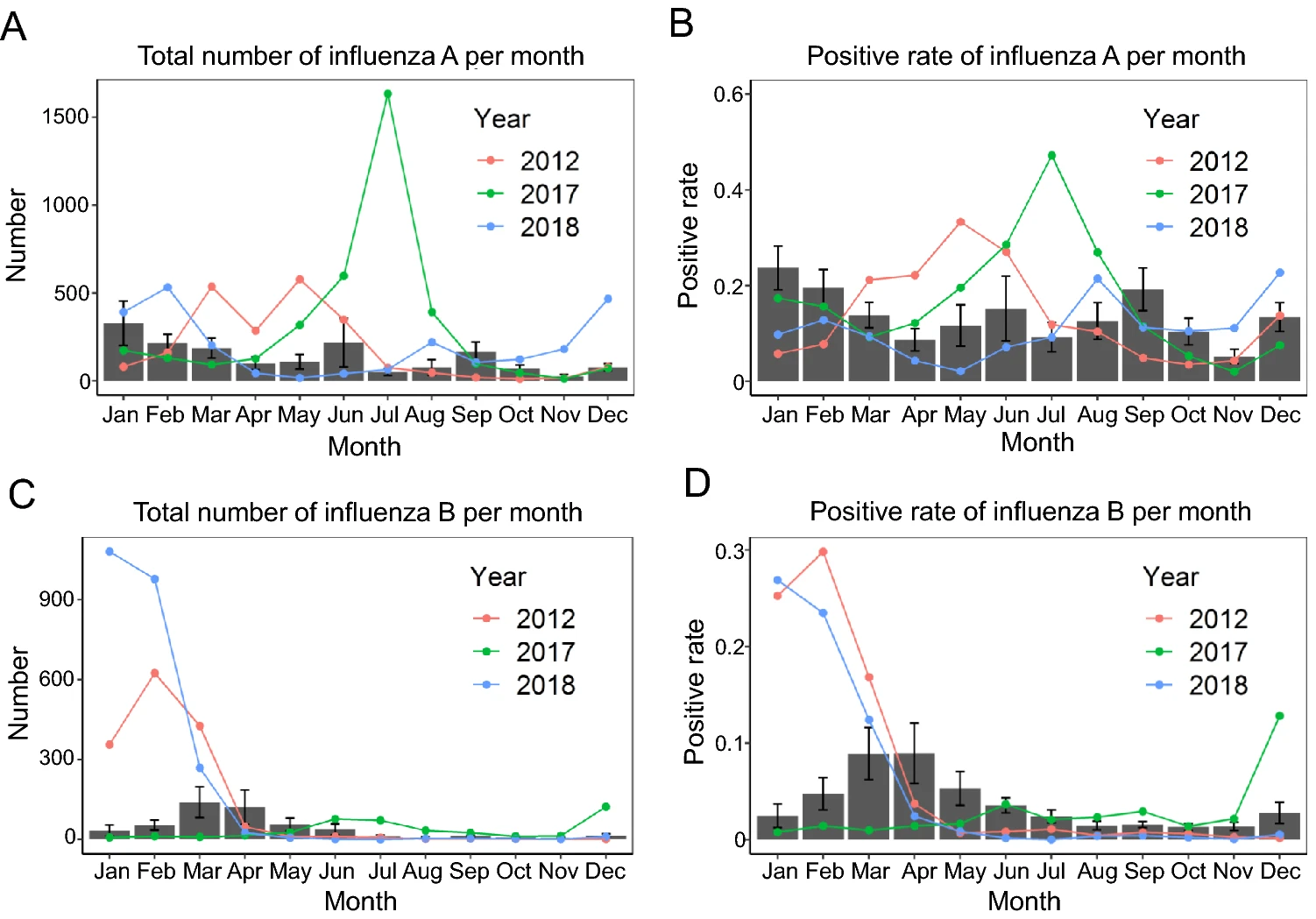
Epidemiological Characteristics of Influenza A and B in Macau, 2010–2018
2021, 36(5): 1144 doi: 10.1007/s12250-021-00388-6
Received: 04 December 2020 Accepted: 04 March 2021 Published: 20 May 2021Influenza is one of the major respiratory diseases in humans. Macau is a tourist city with high density of population and special population mobility. The study on the epidemiological characteristics of influenza in Macau should bring great value for preventing influenza in tourist cities like Macau in the world. In this study, we collected a total of 104,874 samples with influenza-like illness (ILI) in Macau from 2010 to 2018. Chi-square test and binary multivariable logistic regression were used to investigate the epidemiological characteristics of influenza A and B in Macau. Among these ILI samples, the overall positive rate is 17.17% for influenza A and 6.97% for influenza B. The epidemics of influenza in three years (i.e., 2012, 2017 and 2018) differ from the remaining years (i.e., normal years). In a normal year, influenza A occurs year-round whereas influenza B is seasonal. Our research shows significant differences in influenza infections between different age groups in normal years. Interestingly, our analysis shows no significant difference between locals and tourists in influenza A and B infection in a normal year, whereas the odds of influenza A in tourists were significantly higher than those in locals in July 2017 and the odds of influenza B in tourists were significantly higher than those in locals in January–February 2012 and January–February 2018. This is possibly attributed by the policy of free vaccination to everyone in Macau. These findings should be valuable for preventing influenza in not only Macau but also the world.
-
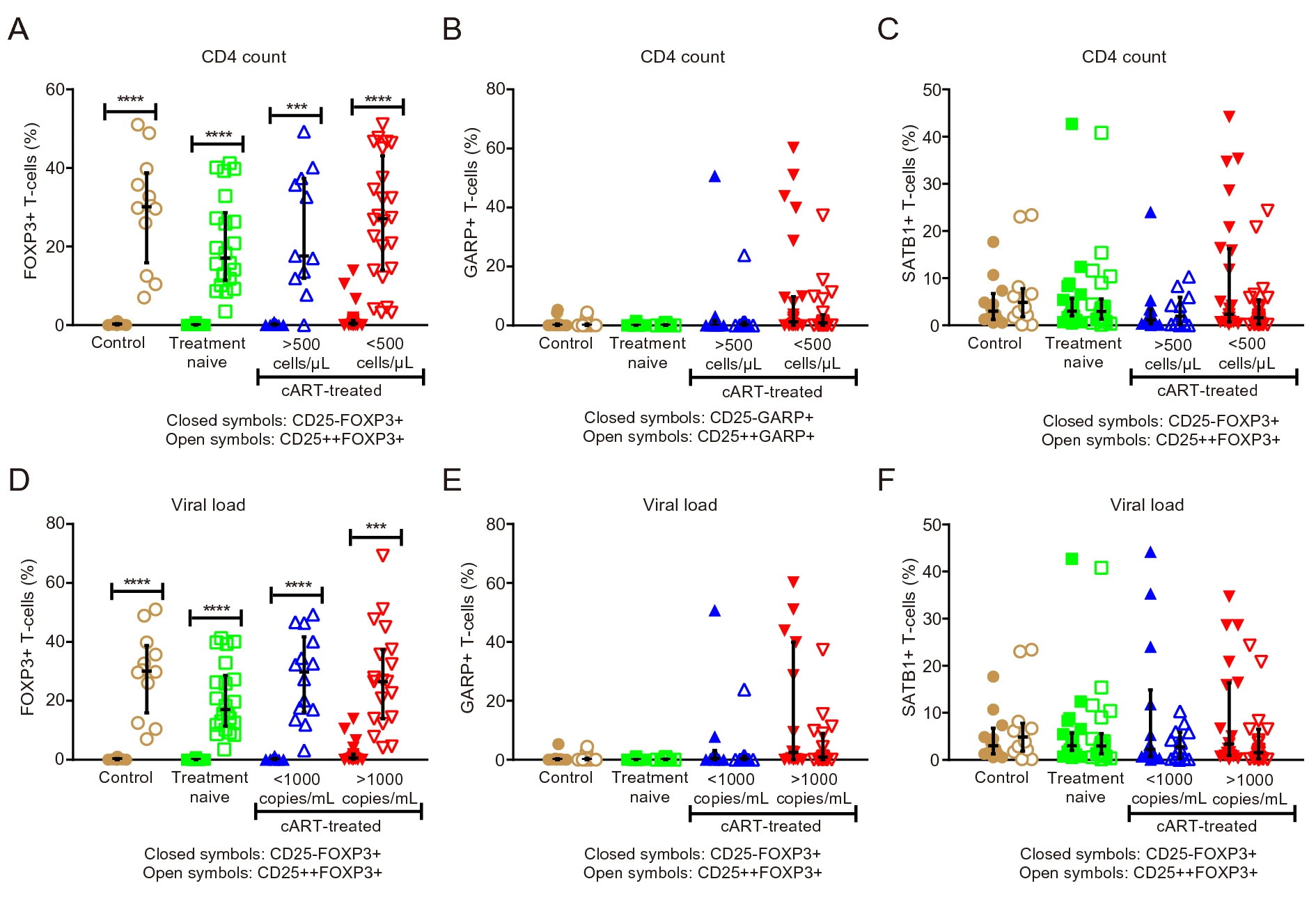
Expansion of GARP-Expressing CD4+CD25-FoxP3+ T Cells and SATB1 Association with Activation and Coagulation in Immune Compromised HIV-1-Infected Individuals in South Africa
2021, 36(5): 1133 doi: 10.1007/s12250-021-00386-8
Received: 17 September 2020 Accepted: 23 February 2021 Published: 11 May 2021Although antiretroviral treatment lowers the burden of human immunodeficiency virus (HIV)-related disease, it does not always result in immunological recovery. This manifests as persistent chronic inflammation, immune activation or exhaustion that can promote the onset of co-morbidities. As the exact function of regulatory T (Treg) cells in HIV remains unclear, this cross-sectional study investigated three expression markers (Forkhead box protein P3 [FOXP3], glycoprotein A repetitions predominant [GARP], special AT-rich sequence binding protein 1 [SATB1]) and compared their expansion between CD4+CD25- and CD4+CD25++ T cells. Age-matched study subjects were recruited (Western Cape, South Africa) and sub-divided: HIV-negative subjects (n = 12), HIV-positive naïve treated (n = 22), HIV-positive treated based on CD4 count cells/μL (CD4 > 500 and CD4 < 500) (n = 34) and HIV-treated based on viral load (VL) copies/mL (VL < 1000 and VL > 1000) (n = 34). Markers of immune activation (CD38) and coagulation (CD142) on T cells (CD8) were assessed by flow cytometry together with FOXP3, GARP and SATB1 expression on CD4+CD25- and CD4+CD25++ T cells. Plasma levels of interleukin-10 (IL-10; anti-inflammatory marker), IL-6 (inflammatory marker) and D-dimer (coagulation marker) were assessed. This study revealed three major findings in immuno-compromised patients with virological failure (CD4 < 500; VL > 1000): (1) the expansion of the unconventional Treg cell subset (CD4+CD25-FOXP3+) is linked with disease progression markers; (2) increased GARP expression in the CD4+CD25- and CD4+CD25++ subsets; and (3) the identification of a strong link between CD4+CD25-SATB1+ cells and markers of immune activation (CD8+CD38+) and coagulation (CD8+CD142+ and D-dimer).
-

Accelerated Evolution of H7N9 Subtype Influenza Virus under Vaccination Pressure
2021, 36(5): 1124 doi: 10.1007/s12250-021-00383-x
Received: 21 October 2020 Accepted: 17 March 2021 Published: 11 May 2021No avian H7N9 outbreaks have occurred since the introduction of H7N9 inactivated vaccine in the fall of 2017. However, H7N9 is still prevalent in poultry. To surveil the prevalence, genetic characteristics, and antigenic changes of H7N9, over 7000 oropharyngeal and cloaca swab specimens were collected from live poultry markets and farms in 15 provinces of China from 2017 to 2019. A total of 85 influenza virus subtype H7N9 strains were isolated and 20 representative strains were selected for genetic analysis and antigenicity evaluation. Results indicated the decreased prevalence of low-pathogenic H7N9 strains while highly-pathogenic H7N9 strains became dominated since the introduction of vaccine. Phylogenetic analysis showed that strains from 2019 formed an independent small branch and were genetically distant to strains isolated in 2013–2018. Analysis of key amino acid sites showed that the virus strains may adapt to the host environment evolutionally through mutation. Our analysis predicted additional potential glycosylation sites for HA and NA genes in the 2019 strains. Sequence analysis of HA gene in strains isolated from 2018 to 2019 showed that there were an increased nucleotide substitution rate and an increased mutation rate in the first and second nucleotides of coding codons within the open reading frame. The hemagglutination inhibition (HI) assay showed that H7-Re1 and H7-Re2 exhibited a lower HI titer for isolates from 2019, while H7-Re3 and rLN79 showed a high HI titer. The protective effect of the vaccine decreased after 15 months of use. Overall, under vaccination pressure, the evolution of influenza virus subtype H7N9 has accelerated.
-
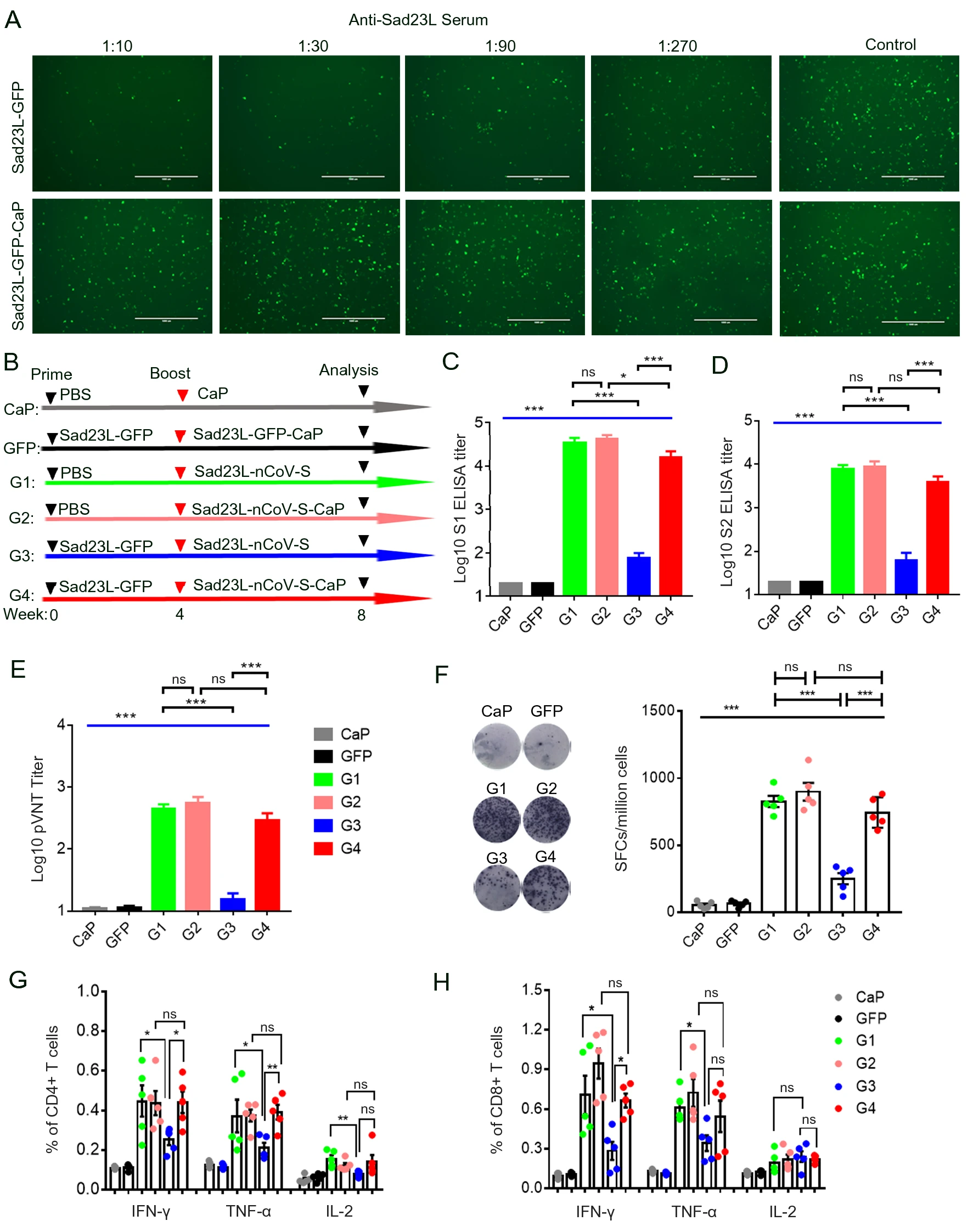
A Self-Biomineralized Novel Adenovirus Vectored COVID-19 Vaccine for Boosting Immunization of Mice
2021, 36(5): 1113 doi: 10.1007/s12250-021-00434-3
Received: 08 May 2021 Accepted: 28 June 2021 Published: 28 September 2021SARS-CoV-2 has caused more than 3.8 million deaths worldwide, and several types of COVID-19 vaccines are urgently approved for use, including adenovirus vectored vaccines. However, the thermal instability and pre-existing immunity have limited its wide applications. To circumvent these obstacles, we constructed a self-biomineralized adenovirus vectored COVID-19 vaccine (Sad23L-nCoV-S-CaP) by generating a calcium phosphate mineral exterior (CaP) based on Sad23L vector carrying the full-length gene of SARS-CoV-2 spike protein (S) under physiological condition. This Sad23L-nCoV-S-CaP vaccine was examined for its characteristics of structure, thermostability, immunogenicity and avoiding the problem of preexisting immunity. In thermostability test, Sad23L-nCoV-S-CaP could be stored at 4 ℃ for over 45 days, 26 ℃ for more than 8 days and 37 ℃ for approximately 2 days. Furthermore, Sad23L-nCoV-S-CaP induced higher level of S-specific antibody and T cell responses, and was not affected by the pre-existing anti-Sad23L immunity, suggesting it could be used as boosting immunization on Sad23L-nCoV-S priming vaccination. The boosting with Sad23L-nCoV-S-CaP vaccine induced high titers of 105.01 anti-S1, 104.77 anti-S2 binding antibody, 103.04 pseudovirus neutralizing antibody (IC50), and robust T-cell response of IFN-γ (1466.16 SFCs/106 cells) to S peptides, respectively. In summary, the self-biomineralization of the COVID-19 vaccine Sad23L-nCoV-S-CaP improved vaccine efficacy, which could be used in prime-boost regimen for prevention of SARS-CoV-2 infection in humans.
-
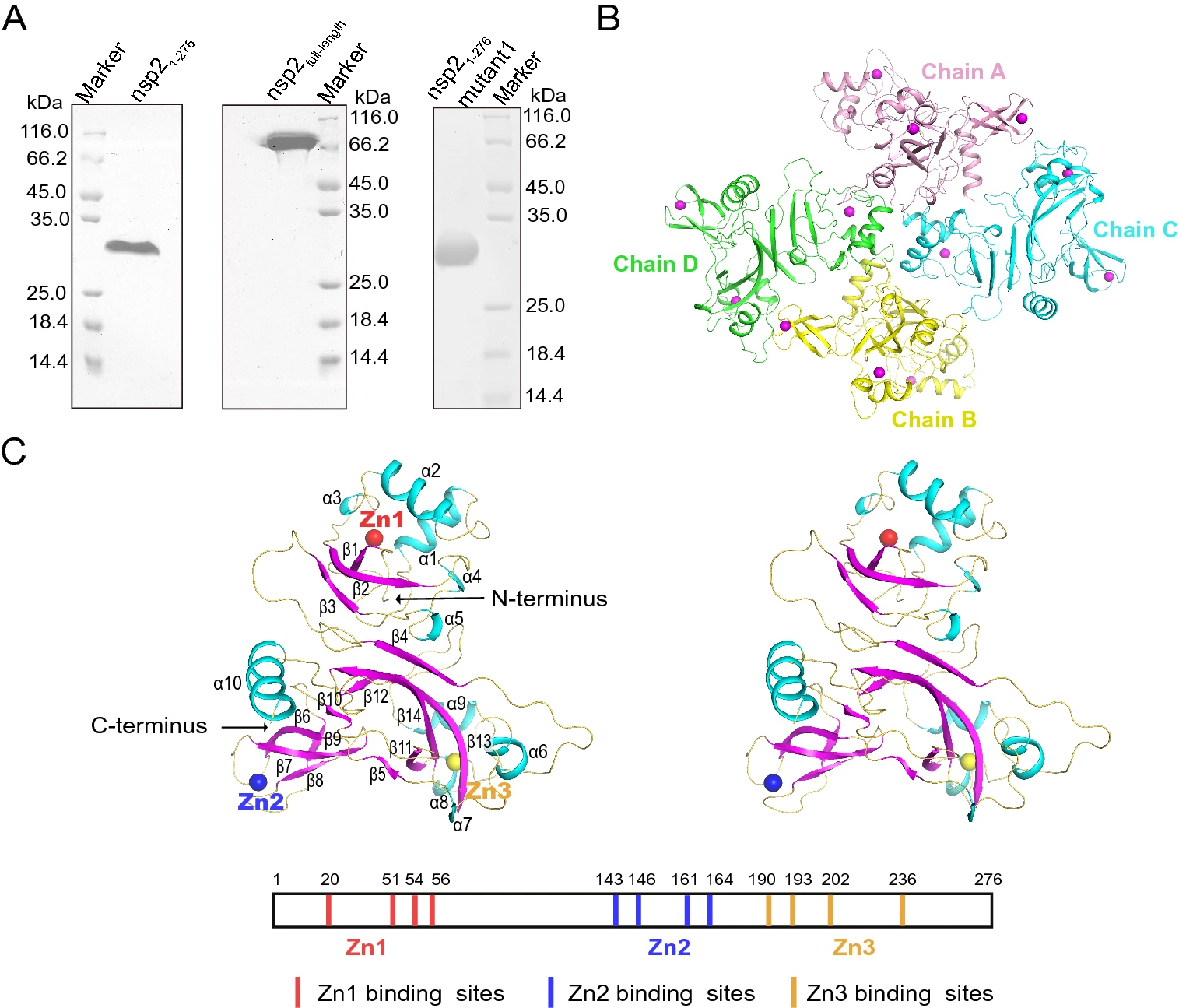
Structure and Function of N-Terminal Zinc Finger Domain of SARS-CoV-2 NSP2
2021, 36(5): 1104 doi: 10.1007/s12250-021-00431-6
Received: 14 June 2021 Accepted: 15 July 2021 Published: 16 August 2021SARS-CoV-2 has become a global pandemic threatening human health and safety. It is urgent to find effective therapeutic agents and targets with the continuous emergence of novel mutant strains. The knowledge of the molecular basis and pathogenesis of SARS-CoV-2 in host cells requires to be understood comprehensively. The unknown structure and function of nsp2 have hindered our understanding of its role in SARS-CoV-2 infection. Here, we report the crystal structure of the N-terminal of SARS-CoV-2 nsp2 to a high resolution of 1.96Å. This novel structure contains three zinc fingers, belonging to the C2H2, C4, and C2HC types, respectively. Structure analysis suggests that nsp2 may be involved in binding nucleic acids and regulating intracellular signaling pathways. The binding to single or double-stranded nucleic acids was mainly through the large positively charged region on the surface of nsp2, and K111, K112, K113 were key residues. Our findings lay the foundation for a better understanding of the relationship between structure and function for nsp2. It is helpful to make full use of nsp2 as further research and development of antiviral targets and drug design.
- First
- Prev
- 1
- 2
- 3
- Next
- Last
- Total:3
- To
- Go







